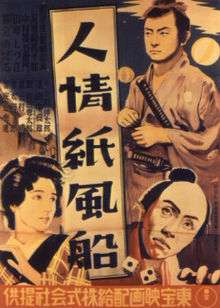Humanity and Paper Balloons
| Humanity and Paper Balloons | |
|---|---|
 Theatrical release poster. | |
| Directed by | Sadao Yamanaka |
| Produced by | Toho |
| Written by | Shintarō Mimura |
| Starring |
Chojuro Kawarazaki Kanemon Nakamura Shizue Yamagishi |
| Music by | Tadashi Ota |
| Cinematography | Akira Mimura |
| Distributed by | Toho |
Release dates |
|
Running time | 86 minutes |
| Country | Japan |
| Language | Japanese |
Humanity and Paper Balloons (人情紙風船 Ninjō Kami Fūsen) is a 1937 black-and-white film directed by Sadao Yamanaka, his last film.
Plot
The story is set in the 18th century, and dramatically depicts the struggles and schemes of Unno, a ronin, or masterless samurai in feudal Japan, as well as those of his similarly impoverished neighbours.
Cast
- Chojuro Kawarazaki
- Kanemon Nakamura
- Shizue Yamagishi
- Noboru Kiritachi
- Tsurozo Nakamura
- Choemon Bando
- Suzeko Suketakaya
- Emitaro Ichikawa
Reception
Largely unknown outside Japan for years, the film has been hailed by critics such as Tadao Sato and Donald Richie, and Japanese filmmakers including Akira Kurosawa, as one of the most influential examples of jidaigeki, or Japanese period films.
Jasper Sharp of Midnight Eye described the film as "a fascinating time capsule of a movie that not only reframes the feudal period in which it is set to present a harsh critique of the social and political conditions of the time it was made, but also demonstrates just how tight, coherent, and entertaining films from this period actually were."[1] In 2012, Spanish film programmer Fran Gayo listed the film as one of the greatest films of all time.[2]
References
- ↑ Sharp, Jasper (21 September 2005). "Midnight Eye review: Humanity and Paper Balloons". Midnight Eye.
- ↑ Gayo, Fran (2012). "Fran Gayo - BFI - British Film Institute". Sight & Sound.
- Donald Richie: 100 Years Of Japanese Cinema, Kodansha, 2003.
- Arne Svensson: Japan: Screen Series, Zwemmer/Barnes, 1970.
External links
- Humanity and Paper Balloons at the Internet Movie Database
- Humanity and Paper Balloons at AllMovie
- Humanity and Paper Balloons at the Japanese Movie Database (Japanese)